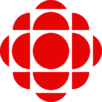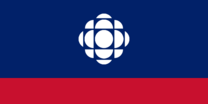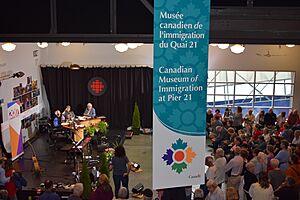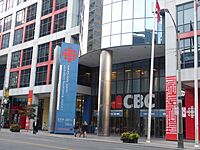Canadian Broadcasting Corporation facts for kids
 |
|

CBC Headquarters in Ottawa, 2019
|
|
| Crown corporation | |
| Industry | |
| Predecessor | Canadian Radio Broadcasting Commission |
| Founded | November 2, 1936 (radio) September 6, 1952 (television) |
| Headquarters | CBC Ottawa Production Centre, Ottawa, Ontario, Canada |
|
Area served
|
National; available on terrestrial and cable systems in northern American border communities; available internationally via Internet, Sirius XM and on TV |
|
Key people
|
|
| Products | |
| Services |
|
| Revenue | |
|
Operating income
|
|
|
Number of employees
|
9,429 (2023) |
| Corporation overview | |
| Minister responsible |
|
| Key document |
|
The Canadian Broadcasting Corporation (CBC), also known as Société Radio-Canada in French, is Canada's national public broadcaster. It provides both radio and television services. The CBC is a special type of company called a Crown corporation. This means it is owned by the government but operates independently. Its English services are known as CBC, and its French services are called Radio-Canada.
The CBC is the oldest broadcasting network in Canada that has been running continuously. It was started on November 2, 1936. The CBC runs several radio networks, including CBC Radio One and CBC Music in English, and Ici Radio-Canada Première and Ici Musique in French. It also has two main television networks: CBC Television (English) and Ici Radio-Canada Télé (French). Beyond these, the CBC offers news channels like CBC News Network and Ici RDI, plus digital services like CBC.ca and Ici.Radio-Canada.ca.
The CBC provides programs in English, French, and eight Indigenous languages on its radio service. It also offers content in five languages through its web-based international radio service, Radio Canada International (RCI). While the CBC gets some money from ads on its TV shows, its main radio networks have been commercial-free since 1974.
Contents
Exploring CBC's History
The CBC has a long and interesting history in Canadian broadcasting.
Early Days of Canadian Radio
In 1929, a group called the Aird Commission suggested creating a national radio network. They were worried about the growing influence of American radio in Canada. Before the CBC, the Canadian National Railways had its own radio network to entertain train passengers. This network was a big step towards what the CBC would become.
In 1932, the government created the Canadian Radio Broadcasting Commission (CRBC), which was the CBC's first version. The CRBC took over the railway's radio stations. Then, on November 2, 1936, the CRBC became the Canadian Broadcasting Corporation, similar to the British Broadcasting Corporation (BBC). Leonard Brockington was the first chairman of the CBC.
For many years, the CBC was at the forefront of broadcasting in Canada. It was not only a broadcaster but also the main regulator of Canadian broadcasting until 1958. It started a separate French-language radio network in 1937 and introduced FM radio to Canada in 1946.
Bringing Television to Canada
Television broadcasts from the CBC began on September 6, 1952, with a station opening in Montreal. A station in Toronto opened just two days later. By July 1, 1958, the CBC's television signal reached across Canada.
The first Canadian TV show filmed in colour was the CBC's The Forest Rangers in 1963. Colour TV broadcasts officially started on July 1, 1966, and by 1974, all CBC television was in colour. In 1978, the CBC was the first broadcaster in the world to use a satellite to deliver TV service, connecting Canada from coast to coast to the North.
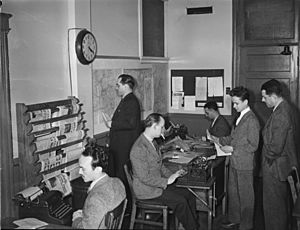
Reaching Remote Communities
From 1967 to the mid-1970s, the CBC offered a "Frontier Coverage Package" to bring limited television service to remote northern communities. Low-power transmitters would show a few hours of black-and-white programs each day. These programs were recorded in Calgary and then flown to communities. After being broadcast, the tapes were moved to other communities.
The first stations for this service started in Yellowknife, Lynn Lake, and Havre-Saint-Pierre in 1967. More stations were added over the next few years. By 1973, most of these stations were updated to receive live, colour CBC Television programs from the Anik satellite. This helped connect northern communities with the rest of Canada.
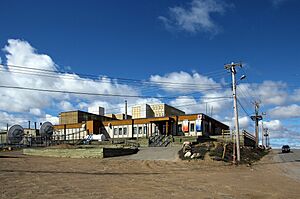
Moving to Digital Television
In 2011, a big change happened in television broadcasting. The Canadian government required that in 28 major cities, old analogue TV signals had to stop by August 31, 2011. Broadcasters had to switch to digital signals or stop broadcasting over-the-air.
The CBC converted some of its transmitters to digital, but not all of them. Due to financial challenges, the CBC decided to shut down many of its analogue television transmitters. On July 31, 2012, the CBC turned off about 620 analogue TV transmitters across the country. This reduced the total number of its TV transmitters to 27. The CBC stated that this change saved money and that most Canadians could still access their programming through cable or satellite.
Focusing on Workplace Culture
In 2015, there were concerns about workplace behaviour at the CBC. The corporation took these concerns seriously and launched an independent investigation. The report from this investigation found that management had not done enough to address some issues.
The CBC apologized publicly and committed to improving its workplace policies. They focused on better training and new ways to handle complaints about bullying and harassment. The CBC also made changes to its leadership to ensure a safer and more respectful environment for all employees.
Protecting Copyrighted Content
The CBC has sometimes had to protect its copyrighted news footage. During federal election campaigns, some political parties used clips from CBC news programs in their ads without permission. The CBC sent letters asking them to stop, explaining that using copyrighted material without permission is not allowed.
In 2021, a court case confirmed that using short clips for "fair dealing" (like for criticism or review) can be allowed. This means that if someone uses a small part of a copyrighted work to comment on it or review it, it might be okay. The court also said that showing the CBC's logo was enough to give credit.
CBC's Visual Identity and Messages
The CBC has used several different logos and slogans over the years to represent itself.
Evolution of CBC Logos
The very first CBC logo, used from 1940 to 1958, showed a map of Canada with a lightning bolt, symbolizing broadcasting. In 1958, a new logo featured "CBC" and "Radio-Canada" over a map of Canada.
In 1966, the "Butterfly" logo was introduced to mark the move from black-and-white to colour television. This colourful logo was used as programs switched to colour.
The most famous CBC logo, known as "the gem" or "The Exploding Pizza," was designed in 1974. It features a large "C" for Canada, with radiating parts symbolizing broadcasting, all within a blue circle representing the world. This logo meant "Canada broadcasting to the world." It was updated in 1986 to a simpler, one-colour version.
In 1992, the CBC updated its logo again, making it simpler and mostly red. This design, with fewer sections and a red circle in the middle, is still used today. It has become the longest-used CBC logo.
Memorable Slogans
The CBC has also used many slogans to connect with Canadians:
- 1966: "Television is CBC"
- 1970: "When you watch, watch the best"
- 1977: "Bringing Canadians Together"
- 1980: "We Are the CBC"
- 1984: "Look to us for good things"
- 1986–1989: "The Best on the Box"
- 1989–1992: "CBC and You"
- 1992–1994: "Go Public"
- 1995–2001: "Television to Call Our Own"
- 2001–2007: "Canada's Own"
- 2007–2014: "Canada Lives Here"
- 2009–present: "Mon monde est à Radio-Canada" (My world is on Radio-Canada)
- 2011 and 2016: "Yours to Celebrate"
- 2014–2023: "Love CBC"
- 2023–present "It's a Canada thing"
Key People at the CBC
Many famous Canadians have worked at the CBC. Some have even gone on to become Governors General, like Jeanne Sauvé and Adrienne Clarkson.
Well-known news anchors like Knowlton Nash and Peter Mansbridge were the faces of The National, the CBC's main news program, for many years.
Since 1952, the CBC has broadcast Hockey Night in Canada every Saturday night. Commentators like Foster Hewitt and Ron MacLean became very famous for their hockey coverage.
How the CBC is Organized
CBC's Important Role
The 1991 Broadcasting Act sets out the CBC's main goals. It says the CBC should provide radio and television services that inform, enlighten, and entertain Canadians.
The programming should:
- Be mostly and clearly Canadian.
- Show Canada and its regions to audiences across the country.
- Help share different cultural expressions.
- Be in both English and French, serving both language groups.
- Try to be of equal quality in English and French.
- Help build a shared national identity.
- Be available across Canada using the best methods possible.
- Show Canada's many different cultures and races.
How the CBC is Managed
As a Crown corporation, the CBC operates mostly independently from the government in its daily work. It follows the Broadcasting Act and is overseen by a board of directors. The president, who manages the organization, is chosen by the Governor General on the advice of the prime minister.
The CBC became subject to the federal Access to Information Act on September 1, 2007. This means people can request information from the CBC, making it more open.
Board of Directors
A board of 12 directors, including the chair and the president, is responsible for managing the CBC. As of April 2025, the board includes Michael Goldbloom (chair) and Marie-Philippe Bouchard (president and CEO).
Past Presidents of the CBC
Many individuals have led the CBC over the years, guiding its direction and services.
- 1936–1939: Leonard Brockington
- 1940–1944: René Morin
- 1944–1945: Howard B. Chase
- 1945–1958: A. Davidson Dunton
- 1958–1967: J. Alphonse Ouimet
- 1968–1972: George F. Davidson
- 1972–1975: Laurent A. Picard
- 1975–1982: A.W. Johnson
- 1982–1989: Pierre Juneau
- 1989: William T. Armstrong
- 1989–1994: Gérard Veilleux
- 1994–1995: Anthony S. Manera
- 1995–1999: Perrin Beatty
- 1999–2007: Robert Rabinovitch
- 2008–2018: Hubert T. Lacroix
- 2018–2025: Catherine Tait
- 2025–present: Marie-Philippe Bouchard
How the CBC is Funded
The CBC receives funding from several sources. A large part of its money comes from the Canadian government through taxes. It also earns money from advertising on its television networks and websites. Some specialty channels, like CBC News Network, also get money from subscriber fees.
Unlike public broadcasters in some other countries that collect a special licence fee, the CBC relies on a mix of government funding and commercial revenue. In 2015, the Liberal Party promised to restore and increase funding to the CBC. Since 2018, the CBC has received about $1.2 billion in annual public funding.
CBC's Services
The CBC offers a wide range of services to Canadians.
News Coverage

CBC News is the largest newsgathering operation in Canada. It provides news for CBC radio, CBC News Network, local TV newscasts, and its online platforms. CBC News also offers digital services like news alerts for phones and email.
Radio Services
CBC Radio has six different services:
- Three in English: CBC Radio One, CBC Music, and CBC Radio 3.
- Three in French: Ici Radio-Canada Première, Ici Musique, and Ici Musique Classique.
CBC Radio One and Première focus on news and information, while CBC Music and Ici musique focus on arts and music. CBC Radio 3 is an online-only service that plays independent Canadian music.
In 2012, the CBC stopped its shortwave radio services, including Radio Canada International, due to budget cuts. However, its radio services are still widely available across Canada.
In 2005, the CBC partnered with Sirius Satellite Radio to offer satellite radio service in Canada. This included new CBC Radio channels. In October 2019, the CBC launched CBC Listen, an online platform for all its radio, music, and podcast content.
Television Services
The CBC operates two national television networks: CBC Television in English and ICI Radio-Canada Télé in French. Both networks show more Canadian-produced programs than private broadcasters. All CBC television stations are owned and operated by the CBC itself.
One of the most popular shows is the weekly Saturday night broadcast of NHL hockey games, known as Hockey Night in Canada. The CBC also owns and operates four specialty television channels: the news channels CBC News Network and Ici RDI, and the French-language networks Ici Explora and Ici ARTV. It also has a share in Documentary Channel.
The CBC provides on-demand television programs through digital cable services. It also has commercial-free children's programming blocks: CBC Kids in English and Zone Jeunesse in French.
Online Platforms
The CBC has two main websites: CBC.ca (English) and Radio-Canada.ca (French). These websites offer content that goes along with their TV and radio programs.
In May 2012, the CBC launched CBC Hamilton, a news operation focused on digital content for the Hamilton, Ontario, area. This helps serve communities with local news online.
In February 2023, the CBC announced it is planning for a future where broadcasting might happen entirely through internet streaming, rather than traditional TV or radio signals.
Other Services
CBC Merchandising sells CBC content and products, including items related to shows like Hockey Night in Canada.
CBC Records is a record label that releases CBC programming, including live concerts and recordings of news and information shows.
The CBC also provides news, business, weather, and sports information for Air Canada's in-flight entertainment.
CBC's International Reach
CBC and Radio-Canada channels are available through cable and satellite TV providers across Canada. They can also be received for free with an antenna in Canada's largest cities and some areas along the Canada–U.S. border.
Reaching the Caribbean
Several Caribbean Countries carry CBC TV channels on their cable systems, including:
Connecting with the United States
CBC radio and television stations are popular in U.S. border communities like Buffalo, New York and Detroit, Michigan. Some American fans even use Canadian internet addresses to stream CBC sports. Some CBC programs are also rebroadcast on local public radio stations in the U.S.
After the September 11 attacks in 2001, several American broadcasters, including C-SPAN, showed the CBC's news coverage. The quality of this coverage was highly praised. C-SPAN has also shown CBC's coverage of other major Canadian events, like federal elections and important Parliament proceedings.
Some PBS stations in the U.S. also air CBC programs, which are distributed by independent companies. Other American news networks sometimes use CBC reports for important Canadian events.
Past International Ventures
From 1994 to 2000, the CBC co-owned two networks in the U.S.:
- Newsworld International (NWI), which rebroadcast much of CBC Newsworld's (now CBC News Network) programming.
- Trio, an arts and entertainment channel.
The CBC later sold its share in these channels. NWI eventually stopped airing CBC programming in 2005 and became Current TV.
International Radio Programs
Some CBC Radio One programs, like Q and As It Happens, are also broadcast on some public radio stations in the United States. CBC Radio One and Ici Radio-Canada Première are available to SiriusXM subscribers in the U.S.
Images for kids
-
Radio Canada International transmitter site (CKCX) in Sackville, New Brunswick in 2009. The site was closed in 2012.
See also
 In Spanish: CBC/Radio-Canada para niños
In Spanish: CBC/Radio-Canada para niños





